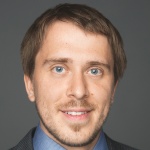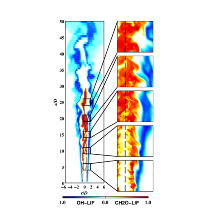Dimethyl ether (DME) is seen as a promising alternative fuel that could potentially replace Diesel in compression ignition (CI) engines. DME is an oxygenated fuel without a direct carbon-carbon bond, which is advantageous in terms of pollutant formation (NOx, CO and soot). Furthermore, DME can be synthesised from a variety of carbonaceous sources and is therefore a promising second-generation biofuel. However, before a widespread application of DME in energy conversion systems can come into place detailed research is required, since DME combustion chemistry is significantly more complex than chemical mechanisms for standard fuels (e.g. methane) and because the interactions of turbulence and chemistry are known to be altered, but not very well understood for DME. In this project we apply multiple mapping conditioning (MMC), a recently developed accurate modelling concept for turbulent flames, coupled to a large eddy simulation (LES) approach to predict non-premixed DME flames. The accuracy of MMC relies on controlling the turbulent mixing operation to enforce mixing that is local in both physical and reference variable space. To this end, we solve an LES-filtered mixture fraction equation and the mixture fraction is used as the reference variable for MMC. A stochastic sparse-Lagrangian implementation of MMC is employed, where a number of stochastic particles smaller than the number of Eulerian grid cells is used to describe turbulence-chemistry interaction. The results obtained from the MMC-LES model are compared to earlier CMC-LES results and to well-defined experimental data from the Sandia DME piloted jet flame series.
Movie 1:
MMC-LES of the Sandia DME piloted jet flame series. The animation shows gas phase temperature. Left, flame DME D, right flame DME G. The Reynolds number of the flame increases when changing from flame D to flame G. This alters the level of turbulence-chemistry interaction, but to a smaller extent for this oxygenated DME fuel, compared with non-oxygenated fuels (e.g. methane).
Related publications
- G. Neuber, F. Fuest, J. Kirchmann, A. Kronenburg, O. T. Stein, S. Galindo-Lopez, M. J. Cleary, R. S. Barlow, B. Coriton, J. H. Frank, and J. A. Sutton, “Sparse-Lagrangian MMC modelling of the Sandia DME flame series,” Combust. Flame, vol. 208, pp. 110–121, (2019).
- G. Neuber, A. Kronenburg, O. T. Stein, M. J. Cleary, B. Coriton, and J. H. Frank, “Sparse-Lagrangian MMC modelling of the Sandia DME (D-F) jet flames,” in 36th Internat. Combust. Symp., Seoul, Republic of Korea, (2016).
- G. Neuber, J. Kirchmann, A. Kronenburg, O. T. Stein, and M. J. Cleary, “Sparse-Lagrangian MMC modelling of a partially-premixed DME/air flame series,” in 11th Internat. ERCOFTAC Symp. Eng. Turb. Model. & Meas. (ETMM), Palermo, Italy, (2016).
- B. Coriton, M. Zendehdel, S. Ukai, A. Kronenburg, O. T. Stein, S.-K. Im, M. Gamba, and J. H. Frank, “Imaging measurements and LES-CMC modeling of a partially-premixed turbulent dimethyl ether/air jet flame,” Proc. Combust. Inst., vol. 35, pp. 1251–1258, (2015).
- G. Neuber, Y. Gao, A. Kronenburg, O. T. Stein, and M. J. Cleary, “LES-MMC modelling of a partially-premixed turbulent DME/air jet flame,” in Proc. Austral. Combust. Symp., Melbourne, Australia, (2015).
Contact

Andreas Kronenburg
Univ.-Prof. Dr.Director of the Institute

Jonas Kirchmann
Scientific staff



